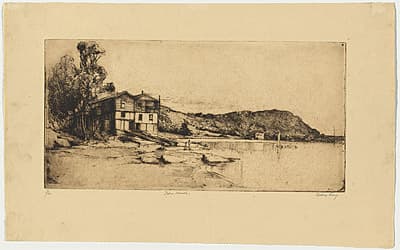
Sydney
LONG
Australia
1871
–
London
1955
England, Europe 1910-21; Australia 1921- 22; England 1922-25; Australia 1925-52; England from 1952
17.5 (h) x 35.2 (w) cm
7/60 , published state , edition of 60 , watermark centre, 'VAN GELDER ZONEN [runs vertically]'
Signed lower right below plate-mark in black pencil, 'Sydney Long'. Titled lower centre below plate-mark in black pencil 'Palm. Beach.' Inscribed with edition details lower left below plate-mark in black pencil, '7/60'.
Reference: Mendelssohn (1979), 75; Paul (1928), 6 National Gallery of Australia, Canberra NGA 1977.9.80 The Stephen Collection, purchased 1976. Reproduced with the kind permission of the Ophthalmic Research Institute of Australia
- J.W.F. Stephen, who formed a definitive collection of the etched work of Sydney Long. J.A.C. Stephen, the artist’s son, by descent. Purchased by the Australian National Gallery, from J.A.C. Stephen, Sydney, 1977.
The wooden boathouse, originally used as a shed for sail making, sits out from the curve of the sandy shoreline in Long’s composition, with a ramp leading down to shallow ripples at the water’s edge. Long sketched the scene sitting on the sand looking towards the mouth of Pittwater as it opens out to the Tasman Sea, opposite West Head and Resolute Beach. The view encompasses the dense shrubbery of Barrenjoey Headland, which divides the opposing sides of the peninsula. Long did not invert his drawing before etching the plate, and consequently the image is in reverse.
By the 1920s, Palm Beach was a haven for popular sports such as fishing, sailing, golf and rowing. Prosperous Sydneysiders maintained second homes or stayed in guesthouses that were dotted around the beach. The Palm Beach Surf Lifesaving Club was established on the beachfront in 1921, and the boathouse that faces north, away from the beach on the Pittwater shoreline, was also built around this time.
A copy of Palm Beach was first exhibited in 1926 at the ‘Sixth annual exhibition of the Australian Painter–Etchers’ Society’, Sydney, June–July (43). An artist’s proof is held by the Art Gallery of New South Wales. It was previously dated 1927, and this has been revised on the basis of the work’s first exhibition date.
Emma Kindred
The wooden boathouse, originally used as a shed for sail making, sits out from the curve of the sandy shoreline in Long’s composition, with a ramp leading down to shallow ripples at the water’s edge. Long sketched the scene sitting on the sand looking towards the mouth of Pittwater as it opens out to the Tasman Sea, opposite West Head and Resolute Beach. The view encompasses the dense shrubbery of Barrenjoey Headland, which divides the opposing sides of the peninsula. Long did not invert his drawing before etching the plate, and consequently the image is in reverse.
By the 1920s, Palm Beach was a haven for popular sports such as fishing, sailing, golf and rowing. Prosperous Sydneysiders maintained second homes or stayed in guesthouses that were dotted around the beach. The Palm Beach Surf Lifesaving Club was established on the beachfront in 1921, and the boathouse that faces north, away from the beach on the Pittwater shoreline, was also built around this time.
A copy of Palm Beach was first exhibited in 1926 at the ‘Sixth annual exhibition of the Australian Painter–Etchers’ Society’, Sydney, June–July (43). An artist’s proof is held by the Art Gallery of New South Wales. It was previously dated 1927, and this has been revised on the basis of the work’s first exhibition date.
Emma Kindred
The wooden boathouse, originally used as a shed for sail making, sits out from the curve of the sandy shoreline in Long’s composition, with a ramp leading down to shallow ripples at the water’s edge. Long sketched the scene sitting on the sand looking towards the mouth of Pittwater as it opens out to the Tasman Sea, opposite West Head and Resolute Beach. The view encompasses the dense shrubbery of Barrenjoey Headland, which divides the opposing sides of the peninsula. Long did not invert his drawing before etching the plate, and consequently the image is in reverse.
By the 1920s, Palm Beach was a haven for popular sports such as fishing, sailing, golf and rowing. Prosperous Sydneysiders maintained second homes or stayed in guesthouses that were dotted around the beach. The Palm Beach Surf Lifesaving Club was established on the beachfront in 1921, and the boathouse that faces north, away from the beach on the Pittwater shoreline, was also built around this time.
A copy of Palm Beach was first exhibited in 1926 at the ‘Sixth annual exhibition of the Australian Painter–Etchers’ Society’, Sydney, June–July (43). An artist’s proof is held by the Art Gallery of New South Wales. It was previously dated 1927, and this has been revised on the basis of the work’s first exhibition date.
Emma Kindred
